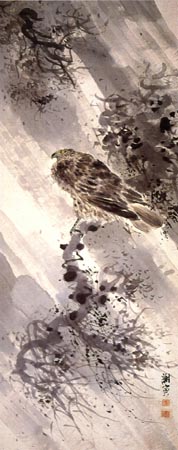| architecture |
| calligraphy |
| ceramics |
| clothing |
| comics |
| gardens |
| lacquerwork |
| literature |
| movies |
| music |
| painting |
| poetry |
| sculpture |
| tea ceremony |
| television |
| theatre |
| weaponry |
| thematic routes |
| timeline |
| the site |
context: painting > great schools

|
Kite, by Yosa Buson |
Nanga or Literati
This is an odd one. The last wave of Chinese influence on Japanese painting began late in the seventeenth century, where a group of Japanese artists realised that what had been the major Chinese influence on Japanese landscape painting over recent centuries (see the Zen and Kano sections here, for instance) was the style of the professional painter. There is a sense of pained embarrassment, an "Oh no, we've been copying the artisan, not the higher aristocratic form! They'll be pointing at us and laughing!"
So they started copying the Chinese 'literati', aristocratic part-time painters, with an idea that this was purer, and not tainted with commercialism or mere craftsmanship. The contradictions soon started to show: the Japanese people adopting this were often not at all aristocratic, and were professional artists - indeed some were as openly commercial as any artists ever, turning painting into a spectator sport; which in turn caused a difficult counter-pull against the ideas of super-subtle brushstrokes with shades of meaning only comprehensible to an elite. So we had aristocratic, elitist amateurism promoted enthusiastically by plebeian, populist professionals.
I think that much of the work is only appealing for its bizarre brushwork (it reminds me of late Van Gogh, or even Seurat's pointillism at times), and the subjects and compositions are the most stultefyingly monotonous that any art movement in the world has ever produced, but there were a few excellent artists...
Yosa Buson
Ike Taiga
Tani Buncho
Uragami Gyokudo
backwards: Rimpa
forwards: Maruyama-Shijo
